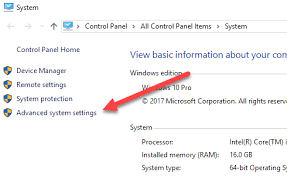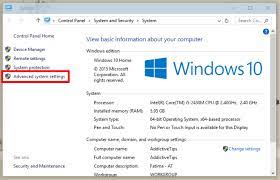10 Commandments for Setting Environment Variables in Windows

10 Commandments for Setting Environment Variables in Windows
Setting environment variables in Windows can be a bit of a pain, but it doesn’t have to be. Here are 10 commandments for setting environment variables in Windows that will make your life a whole lot easier:
1. Thou shalt not set environment variables in the GUI.
The GUI is great for many things, but setting environment variables is not one of them. It’s much better to use the command line for this task.
2. Thou shalt use setx instead of set.
Setx is a much better tool for setting environment variables than set. Setx allows you to specify whether you want the variable to be set globally or just for the current user, and it also has a few other handy features that set doesn’t have.
3. Thou shalt use quotes around values with spaces in them.
If you try to set an environment variable without quotes around values that contain spaces, you’ll end up with two separate values instead of one. So always use quotes around values with spaces in them.
4. Thou shalt not put trailing slashes on path entries.
Trailing slashes on path entries can cause all sorts of problems, so don’t do it! Remove any trailing slashes from your path entries before setting the environment variable.
5 .Thou shalt use forward slashes in path entries, even on Windows.
While Windows does technically allow you to use backslashes in paths,
make a normal windows/smb share
To make a normal Windows/SMB share, you’ll need to set some environment variables. Here are the 10 commandments for doing so:
1) Thou shalt set the SMB_SHARE environment variable to the name of the share.
2) Thou shalt set the SMB_SERVER environment variable to the name of the server.
3) Thou shalt set the SMB_USERNAME environment variable to the username of the account with access to the share.
4) Thou shalt set the SMB_PASSWORD environment variable to the password of the account with access to the share.
5) Thou shalt set the SMB_DOMAIN environment variable to the domain of the account with access to the share.
6) Thou shalt mount the share using theMount command.
7) Thou shalt unmount the share usingthe Unmount command.
8) Thou shalt access files onthe share usingthe Get-ChildItem command.
9) Thou shalt copy files to and fromthe share usingthe Copy-Item command.
10) When thou art finished usingthe share, thou shalt unset all environment variables associated with it usingthe Remove-Item command.
copy in cmd windows
When working in the command line in Windows, you may need to set environment variables in order to run certain programs or commands. Here are some tips for doing this:
1. Make sure you have the correct permissions. In order to set environment variables, you will need to be an administrator on the machine.
2. Know what you want to set the environment variable for. There are many different types of environment variables, so make sure you know which one you need to set in order to accomplish your task.
3. Use the set command. This is the command that you will use to actually set the environment variable. The syntax is as follows: set [variable name]=[value].
4. Check your work. Once you have set the environment variable, you can check it by using the echo command. This will print out the value of the variable to the console.
5. Save your changes. If you want your changes to persist after reboot, you will need to save them in a persistent location. The best way to do this is by editing the registry or by creating a batch file.
How to set environment variables in Windows

There are two ways to set environment variables in Windows: using the GUI, or via the command line.
To set an environment variable using the GUI:
1. Go to Start > Control Panel > System.
2. Click on Advanced system settings. This will open the System Properties dialog.
3. Click on Environment Variables… This will open the Environment Variables dialog.
4. Under System Variables, click New…. This will open the New System Variable dialog.
5. Enter the name and value of your new system variable and click OK.
6. Close all remaining dialogs by clicking OK .
To set an environment variable using the command line:
1) Open the Command Prompt window by going to Start > Run and typing cmd . Press Enter . 2) Type SET followed by a space and then enter your variable name, equals sign (=), and value for example, SET foo=bar 3)Press Enter
The difference between system and user environment variables
is that system environment variables are set by the system administrator and are available to all users, while user environment variables are set by individual users and are only available to those users.
System environment variables typically include things like the PATH variable, which tells the system where to find executables, and theHOME variable, which determines the default directory for a user’s home folder. User environment variables can be anything that the user wants them to be, and are often used to customize the behavior of programs or scripts.
How to view and edit environment variables
There are two ways to view and edit environment variables in Windows: via the Command Prompt or the GUI.
To view environment variables using the Command Prompt, you can use the set command. This will display all environment variables currently set on your system. To edit an environment variable, you can use the setx command. This will allow you to edit both user-level and system-level environment variables.
To view and edit environment variables via the GUI, go to Control Panel -> System -> Advanced system settings -> Environment Variables. This will bring up a window where you can view and edit both user-level and system-level environment variables.
Tips for setting environment variables
1. Make sure you have the correct permissions to set environment variables. Depending on your system, you may need administrator privileges to set environment variables.
2. Be aware of the different types of environment variables. There are system-wide and user-specific environment variables. System-wide variables are available to all users on a system, while user-specific variables are only available to the specific user account that sets them.
3. Know where to set environment variables. The location for setting environment variables varies depending on your operating system and shell type. For example, in Windows you can set them in the Control Panel, while in Linux they can be set in the .bashrc file for Bash users or the .zshrc file for ZShell users.
4. Choose sensible names for your environment variables so that it is easy to remember what they are used for later on.
5. Be careful when overriding existing environment variable values as this can cause unexpected problems with programs that depend on those values being set correctly
windows package managers
There are several windows package managers out there. We recommend using Chocolatey, a package manager for Windows.
With Chocolatey, you can install and update your software with a single command. Simply open a command prompt and type “choco install ” to install a new package. To update an existing package, type “choco update “.
Chocolatey takes care of dependencies for you, so you don’t have to worry about installing them manually. It also handles environment variables automatically, so you don’t need to set them yourself.
Other popular windows package managers include NuGet and PowerShellGet.
